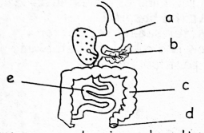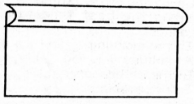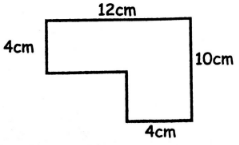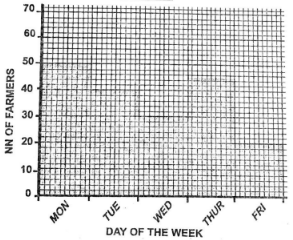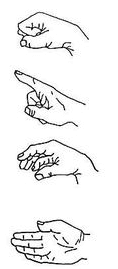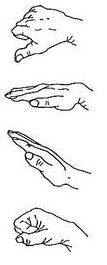Displaying items by tag: grade 5
Integrated Science Questions and Answers - Grade 5 End of Term 2 CBC Exams 2022 Set 1
SCIENCE AND TECHNOLOGY (20mks)
- The following are protective clothes while visiting a school farm. Which one is not ?
- Gloves
- Overalls
- Gumboots
- Shirts
- The following are examples of non- flowering plants. Which one is not ?
- Moss
- Fern
- Cedar
- Grass
- Which one of the following group of plants contains harmful plants?
- Sodom apple, datura, euphorbia
- Datura, maize, sodom apple
- Beans, stinging, nettle, oxalis
- Sodom apple, millet, sorghum
- Which one of the following is a fungi?
- Bread
- Bread moulds
- Pollen grains
- Rotting logs
- Animals that have a backbone are known as
- invertebrates
- vertebrates
- reptiles
- insects
- Study the list of animals below: Tilapia, Lizards, Snakes, Crocodiles, Newts, Toads, Salamanders
From the list above pick the group that has amphibians only?- Toads, salamanders, newts
- Tilapia, toads, newts
- Lizards, snakes, crocodiles
- Salamanders, snakes, newts
- Which of the following bones of a human skeleton is wrongly matched with where it is found?
- Skull - head
- Ribcage - chest region
- Backbones - the back of the body
- Limb bones - the face
- The following are diseases that affect the breathing system. Which one is not?
- Tuberculosis
- Asthma
- Influenza
- HIV/AIDS
- Diseases that are caused by drinking contaminated water are known as
- Respiratory diseases
- Deficiency diseases
- Water borne diseases
- Comunicable diseases
- The following are ways of preventing cholera. Which one is
- Drinking treated water
- Washing hands before taking meals
- Drinking boiled water
- Disposing feaces in the rivers
- Which one of the following is a parasite?
- Lice
- Bee
- Housefly
- Butterfly
- Identify the type of internal parasite shown below.
- Hookworm
- Roundworm
- Pinworms
- Tapeworm
The diagram above shows a model of the human breathing system. What does the part marked X represent?- Gullet
- Wind pipe
- Oesophagus
- Bronchus
- The following are characteristics of amphibians. Which one is not?
- They have a moist skin
- They lay eggs
- They are cold blooded
- They do not take care of their young ones
- A chameleon responds to changes in the environment by
- running away
- changing its colour
- hiding in its shell
- flying off
- The following are parts of a computer except
- monitor
- mouse
- keyboard
- chair
- The teeth we use to chew food are known as
- canines
- incisors
- molars
- nails
- Name the digital device shown below
- camera
- laptop
- mobile phone
- computer
- The diagram below shows the human digestive system.
Water and mineral salts are known as absorbed in the part marked _____________- a
- b
- c
- d
- Three of the following can sink in water. Which one cannot?
- Nail
- Coin
- Bottle top
- Stone
AGRICULTURE
- Learners of Kasarani Primary School noticed that there were V- shaped trenches left by running water in their fields. Which type of soil erosion had taken place?
- Rill
- Gulley
- Sheet
- Splash
- Which of the following human activities contributes to soil erosion
- Mulching
- Afforestation
- Deforestation
- Crop rotation
- Putting dry grass on top of the seed on the ground after planting is known as
- Sowing
- gardening
- thinning
- mulching
- The following are small animals that destroy crops. Which one is not?
- Moles
- Weaver birds
- Monkeys
- Dogs
- Which of the following is not worn when handling small wild animals?
- Gloves
- Masks
- Gumboots
- Suit
- The following are types of soil except
- sand
- clay
- loam
- manure
- Identify the farm tool shown below
- Jembe
- Panga
- Rake
- Spade
- Which of the following indegenous plants grows in dry areas?
- Pigweed
- Sorghum
- Yams
- Black night shade
- The removal of unwanted plants is known as
- Prunning
- Weeding
- Uprooting
- Thinning
- What is the best time to plant seedlings?
- In the morning
- At midday
- In the afternoon
- In the evening
HOMESCIENCE
- Which of the following is a factor that should be considered when buying shoes?
- Date of manufacture
- Size of the shoe
- Number of pairs
- Name fo the seller
- The following are factors that lead to time wastage. Which one does not?
- Uncontrolled use of media
- Preparing a work plan
- Excessive playing
- Poor planning of time
- Which of the following is not a material used for making surfaces found at home?
- Clay
- Tiles
- Wood
- Cement
- Which one of the following is not a communicable disease?
- Chicken pox
- Scabies
- Measles
- Diabetes
- Pouring excess water on a wooden surface can lead to
- Rotting
- Baking
- Drying
- Cleanliness
- Which of the following is not a macro-nutrient?
- Fats
- Vitamins
- Carbohydrates
- Proteins
- Which of the following is not a symptom of Kwashiorkor?
- Brownish and thin hair
- Swollen body parts
- Protruding belly
- Pale finger nails
- Grade five learners made the stitch shown below. What is the name of the stitch?
- Hemming stitch
- Even tacking stitch
- Herringbone stitch
- Back stitch
- Which of the following is not a step in laundry work?
- Sorting
- Blousing
- Washing
- Mending
- Pulses are also known as
- Cereals
- rice
- maize
- legumes
PHYSICAL AND HEALTH EDUCATION
- How many players are there in a soccer match?
- 11
- 14
- 22
- 7
- Which of the following is not a content of a First Aid Kit?
- Pain killers
- Bandage
- Razor blades
- Gloves
- In relay which material cannot be used to improvise a batton?
- manila
- Plastic paper
- Stick
- Iron metal
- Which is the best resting position?
- Sitting
- Lying on the back
- Lying on the left side
- Lying on the right side
- When should First Aid be administered in games and sport?
- Immediately after the accident
- A few minutes after the accident
- At the hospital
- After seeing the doctor
- Below is a rounder's bat. Name the part labelled B
- Grip
- Barrel
- Knob
- End cap
- Warm up activities are important because they
- relax the muscles without being sore
- help the muscles stretch without being injured
- help the to prevent injuries
- help the hearbeat to go back to normal gradually
- Which game is played in the equipment shown below?
- Netball
- Volleyball
- Handball
- Basket ball
- The following are skills learnt during rope skipping. Which one is not?
- Wounded duck
- Skier
- Volley
- Straddle
- A score in rugby is called?
- run
- goal
- try
- point
MARKING SCHEME
- D
- D
- A
- B
- B
- A
- D
- D
- C
- D
- A
- D
- B
- D
- B
- D
- C
- A
- C
- C
- B
- C
- D
- D
- D
- D
- D
- B
- B
- D
- B
- B
- A
- D
- A
- A
- D
- D
- B
- D
- C
- A
- B
- B
- A
- A
- C
- B
- C
- C
Kiswahili Questions and Answers - Grade 5 End of Term 2 CBC Exams 2022 Set 1
Some mazungumzo yafuatayo kisha ujibu maswall 1-5.
(Mwalimu na wanafunzi wanajadiliana kuhusu umuhimu wa kuyatunza mazingira)
Mwalimu: Hamjambo wanafunzi?
Wanafunzi: (Wakiamka sawia) Hatujambo mwalimu, shikamoo.
Mwalimu: Marahaba (Anawaashiria wakae. Wote wanaketi na kushukuru.) Naam, leo ningependa tuzungumze kuhusu namna na umuhimu wa kuyatunza mazingira kwa hivyo...
Matayo: (Anaunyanyua mkono wake) Samahani mwalimu, mazingira ni nini?
Mwalimu: (Akitabasamu) Matayo huishi vituko! Ndilo nililotaka kueleza. Mazingira ni yale yote yanayotuzunguka. Hebu pendekezeni njia mbalimbali za kuyatunza mazingira
Manyanga: Nadhani ni vyema kukata nyasi ndefu ili kuharibu makao ya mbu.
Kaisari: Ni vyema pia kutunza vyanzo vya maji kama vile mito, chemichemi, mabwawa na maziwa.
Pendo: Nikiongezea, si vyema kutumia mbolea nyingi zaidi hasa za madukani ili tusiyaathiri maji na udongo.
Mwalimu: Nimefurahia mno michango yenu. Zipo njia nyingi za kuyatunza mazingira. Kimsingi, umuhimu wa kuyatunza mazingira ni kuwafanya viumbe waishi maisha salama.
- Mazungumzo haya yaliandaliwa majira ya saa ngapi?
- Saa sita adhuhuri.
- Saa mbili asubuhi.
- Saa kumi jioni.
- Hatujaelezwa.
- Ili kuonyesha heshima kuu, mwalimu alipowaamkia wanafunzi, wote
- walisimama ili kupokea salamu yake.
- walitaka kuchangia katika majadiliano
- walitaka kujua maana ya mazingira.
- walitaja umuhimu wa kuishi katika mazingira safi.
- Ni mwanafunzi yupi aliyemkatiza mwalimu alipokuwa akiongea?
- Manyanga .
- Matayo
- Kaisari
- Pendo
- Kulingana na mazungumzo haya, yote yanayotuzunguka ndiyo
- mazingara.
- hewa.
- miti.
- mazingira.
- Mwishoni, mwalimu alifurahishwa na nini?
- Heshima ya wanafunzi wake.
- Umuhimu wa kuyatunza mazingira.
- Michango ya wanafunzi wake.
- Njia mbalimbali za kuyatunza mazingira.
Soma kifungu kifuatacho kisha ujibu maswali 6 hadi 8.
Siku moja paka na mbwa walienda karamuni. Mwenyeji wao, panya, aliwakaribisha kwa mikono miwili. Wageni waliketi sebuleni kwenye makochi maridadi, mekundu, kama damu.
“Habari za mtokako?" Panya aliwaamkia wageni kwa heshima. "Njema sana!” wageni walijibu pamoja huku wakitabasamu. Baadaye, panya aliwasha runinga na kuwaambia wageni wake, “Tazameni televisheni. Mimi naelekea mekoni kuwapikia chakula.” Mara, huyoo! Akaenda jikoni. Haraka, alipika nyama na kuitia mchuzi wa maziwa.
- Paka na mbwa waliandaliwa nini na mwenyeji wao?
- Nyama na maziwa
- Njugu na maziwa.
- Maziwa na mifupa.
- Chai na nyama.
- Kabla ya panya kuelekea mekoni,
- aliwaandalia wageni wake chakula.
- aliwasha televisheni.
- alipika nyama.
- alitia maziwa katika nyama.
- Panya alienda jikoni
- kuwasha runinga.
- kununua chakula.
- kupika chakula.
- kuwakaribisha wageni.
- Kati ya hawa, ni mnyama yupi hajatajwa katika ufahamu?
- Paka
- Panya
- Mbwa
- Sungura
Soma kifungu kifuatacho kisha ujibu maswali 9 hadi 12.
Lengo la elimu ni kumsaidia mtoto kukuza ujuzi na vipawa na kukuza maadili ya maisha pamoja na maisha ya kiroho. Leo, mwalimu si mkufunzi au msimamizi bali ni msaidizi na mwelekezi. Hapa, mwalimu hudokeza au kutoa habari za juujuu tu. Ni jukumu la mwanafunzi kuleta umakinifu na kutafuta undani wa habari za mwalimu. Bila shaka, mwalimu anatarajiwa kumsaidia mwanafunzi katika kuufikia undani huo. Mwalimu hampi mwanafunzi ujuzi wowote bali humwonyesha jinsi anavyoweza kuupata ujuzi yeye mwenyewe. Mtoto anapozaliwa, ujuzi huwa ndani yake nao husubiri kuamshwa. Mwalimu amwonyeshe mtoto pale ujuzi ulipo na jinsi anavyoweza kuufanyia mazoezi hadi utokeze vilivyo na kumfaa.
- Kulingana na kifungu, baada ya mwalimu kudokeza jambo fulani, mwanafunzi
- atatafuta ukweli kulihusu.
- atamtegemea katika kila jambo.
- ataweza kupita vizuri katika mitihani.
- atashindwa kabisa kumwelewa.
- Kabla ya ujuzi ulio ndani ya mtoto kuonekana, ni lazima ujuzi huo
- uongozwe.
- uamshwe.
- utokeze.
- ugunduliwe.
- Katika miaka ya sasa, mwalimu ni
- mkufunzi na msimamizi.
- msaidizi na mkufunzi.
- mwelekezi na msimamizi.
- mwelekezi na msaidizi.
Soma kifungu kifuatacho kisha ujibu maswali 13 hadi 15.
Serikali ya nchi hii inawataka watoto wote wapelekwe shuleni wakasome kwa sababu masomo ndio ufunguo wa maisha. Watu wanaowaajiri watoto hata wasisome wanafaa kuhukumiwa ili kupunguza maovu kama hayo.
Mtoto ambaye hana elimu siku hizi huwa na shida nyingi kupita kiasi kwa sababu hawezi kupata ajira nzuri ukubwani. Hii ndiyo sababu serikali inahimiza kila mtoto kupata elimu. Zamani, watoto hawakuwa wakisoma kwa sababu hawakujua umuhimu wa elimu maishani
mwao.
Ili kuzuia magonjwa na njaa, elimu huwa muhimu. Ili kudumisha adabu njema na nidhamu, elimu huwa lazima. Watoto waliolemewa na masomo huwa wa kurandaranda mitaani, wezi au watendaji wa mambo mabaya katika jamii.
- Ni gani si kweli kulingana na taarifa?
- Masomo ni muhimu maishani.
- Serikali inataka watoto wote wasome.
- Zamani, watoto wote walisoma.
- Ni vyema kuwaelimisha watoto.
- Kulingana na kifungu, mtoto ambaye hana elimu siku hizi
- huwa na shida.
- hupendwa na wengi.
- hupata kazi.
- huajiriwa.
- Katika aya ya mwisho, tumeambiwa kuwa watoto wasiosoma huweza kuwa
- wezi na wafanyakazi.
- wa kurandaranda na wenye bidii.
- wenye bidii na wezi.
- wa kurandaranda na wezi.
Soma kifungu kifuatacho. Chagua jibu lifaalo zaidi kati ya yale uliyopewa
Siku hiyo tulikuwa tumeingoja kwa hamu na ghamu. Sote tulifika ____16____ na mapema tukiwa tayari kuabiri ____17____ kuelekea mjini Mwambasani. Hii ilikuwa mara yangu ya ____18____ kuenda huko. Sikuwa nimewahi kwenda huko. Tuliingia ____19____ tukiwa na furaha sana. Mara dereva alilitia gari ufunguo na safari _____20_____
-
- asubuhi
- jioni
- adhuhuri
- usiku
-
- baiskeli
- basi
- ndege
- meli
-
- moja
- mwisho
- tatu
- kwanza
-
- njiani
- safari
- basini
- barabarani
-
- ikaanza
- ukaisha
- ikaendelea
- ukaanza
Katika swali la 21-30, jibu swali kulingana na maagizo uliyopewa.
- Kati ya hizi, ni nomino ipi isiyo katika ngeli ya U-ZI?
- Uteo
- Uzi
- Upishi
- Ufunguo.
- Tulimwona batamzinga akiogelea bwawani. Nomino iliyopigiwa mstari ni
- nominoambata.
- nomino ya wingi.
- nomino dhahania.
- nomino kitenzi jina.
- Kati ya maneno uliyopewa, ni lipi litakuwa la pili katika kamusi?
- Mshikaki
- Mswaki
- Msaada
- Msaragambo
- ii
- iv
- iii
- i
- Mkufu ni pambo ambalo huvaliwa .
- kichwani.
- miguuni.
- shingoni.
- mikononi.
- Chagua sentensi iliyoakifishwa vibaya.
- Juma, Roda na Maria walialikwa shereheni.
- Maembe maparachichi na mananasi hununuliwa wapi.
- Ukimwona, mwambie aje kwangu.
- Je, mliwaona wanyama wapi mbugani?
- Ni upi wingi wa sentensi hii? Karatasi ilichafuliwa na mtoto.
- Karatasi zilichafuliwa na watoto.
- Makaratsi yalichafuliwa na watoto.
- Karatasi zilichafuliwa na mtoto.
- Karatasi ilichafuliwa na watoto.
- Ni yupi kati ya hawa ni ndege wa porini?
- Kuku
- Bata
- Batabukini
- Mwewe
- Kitenzi imba katika kauli ya kutendwa huwa
- imbia.
- imbiwa.
- imbwa.
- imbaimba.
- Chagua kinyume cha sentensi ifuatayo:
Mgeni amesimama karibu na mfalme.- Mgeni hajasimama karibu na mfalme
- Mwenyeji ameketi mbali na malkia
- Mwenyeji amesimama karibu na
- Mgeni ameketi mbali na malkia.
- Kanusha kauli ifuatayo kwa usahihi.
Wewe umeimba vizuri. Wewe- haujaimba vizuri.
- umeimba vibaya.
- hujaimba vibaya.
- hujaimba vizuri.
MARKING SCHEME
- D
- A
- B
- D
- C
- A
- B
- D
- C
- A
- B
- D
- C
- A
- D
- A
- B
- D
- C
- A
- C
- A
- B
- C
- B
- A
- D
- C
- B
- D
English Questions and Answers - Grade 5 End of Term 2 CBC Exams 2022 Set 1
Read the following conversation and then answer questions 1 to 5.
Mother: Come here my son. Bring your books with you books with you. I'd like us to check the arrangement of your work in every learning area. Come on, take the books out.
Son: Of late, I have been arranging my work neatly. Our class teacher, Miss Tari, told all of us the importance of doing so.
Mother: Please open your Mathematics exercise books, both class work and homework as I check English.
Son: Here, can't you see? This is how our Mathematics teacher wants us to arrange our work. Isn't it neat, mama?
Mother: Wow! I am very proud of both you and your teachers. All the work looks well arranged, neat, marked and corrections done. Indeed, you deserve a present from me, son! Come on let us go to the supermarket. I can't wait to get you a gift.
Son: Yees!
- What did the mother want to check from his son's books?
- The amount of work given by the teachers
- The arrangement of her son's work.
- Some unmarked work, if any,
- The cleanliness of the son's books.
- Whose idea was it to always be arranging the work neatly? The
- mother's
- son's
- class teacher's
- pupils'.
- Towards the end of the conversation, the mother seems
- disappointed.
- disorganised.
- sad.
- happy.
- Evidently, the mother thinks that the teachers
- are doing a good work.
- laze around mostly.
- arrange the pupil's work neatly.
- need to be transferred for a better work organization.
- Why did the son deserve a gift?
- His work was quite disorganised.
- There was a supermarket near their home.
- He had pleased his mother.
- The teachers arranged his work well
Read the passage and then answer questions 6 to 9.
Otieno was playing with his younger sister outside the house. Their mother had told them not to kick the ball hard because it could hurt someone or break a window pane. Otieno kicked the ball to his sister. She kicked it back to him. After some time, Otieno decided to kick the ball hard to see whether his sister could catch it. His sister dived to catch the ball but missed it. The ball broke one of the window panes of the house. Otieno's mother was very angry with the children. She took away the ball and told them that they would not play with it again.
- According to the mother, kicking the ball hard would?
- hurt a window pane or break someone.
- break the window panes of the house
- hurt somebody accidentally.
- break a window pane or hurt somebody
- Which game do you think Otieno and his ball hard would sister were playing?
- Netball
- Football
- Basketball
- Handball
- Why couldn't Otieno's sister catch the last ball?
- She feared to be hurt.
- It was kicked so hard.
- She wanted it to break the window pane
- She did not see it.
- What was the children's punishment?
- Not playing with the ball again.
- Not playing again.
- Using a different ball.
- Playing far from the house.
Read the passage and then answer questions 10 to 12.
Trees are always exciting to look at. Many people like their homes surrounded by trees. Many hotels are located in areas with many trees. When you look at a tree, what you see first is the bark that protects the tree trunk and branches. The bark at the bottom is old, rough and cracked. At the top, the bark is young and smooth.
The tallest tree alive today is over 360 feet high! It is a coast redwood growing in California in the USA. There is enough wood in its trunk to build over 300 houses! The other half is underground. These are the roots pushing their way through the thick earth. They can spread out through the soil as far the tree is high.
All people, young and old, should try to make the world beautiful by planting trees. Since the trees are already growing, we should take care of them.
- What have we been told about the redwood in California? It
- has a soft bark.
- has a lot of wood in its bark.
- can build many houses.
- is good for firewood.
- The bark at the bottom of a tree
- is cracked, old and rough.
- can build over three hundred houses.
- looks smooth and young. It
- is rough, young and cracked.
- Trees should be planted by
- young people.
- old people.
- those who do not use them.
- all.
Read the passage and then answer questions 13 to 15.
I hardly slept that night. I kept on thinking about the following day. We were to have a school trip to Amboseli National Park. Those who had paid for the trip were lucky. They would see many wild animals like zebras, elephants, gazelles, buffaloes and giraffes among others. My parents had made the payment and I would accompany the other pupils.
We were to travel by bus. The bus arrived very early in the morning. The class teacher read the list as we boarded the bus. I selected a seat next to the window where I would enjoy looking outside as we travelled.
- The first sentence means that the writer
- slept very hard.
- did not sleep at all.
- did not sleep well.
- stayed awake the whole night.
- According to this passage, who were lucky?
- Those who planned to pay for the
- The pupils who did not pay for the trip. ,
- All the pupils in the writer's class.
- Those who had paid for the trip.
- Which of the following animals has not been mentioned in the passage?
- Lions
- Gazelles
- Zebras
- Elephants
Read the passage below. It contains blank spaces numbered 16 to 20. For each blank space, select the best alternative from the choices given.
Of all the learning areas, I like Mathematics more. It is my ___16___ because I never have difficulty with it and always get good marks in tests. I suppose I am ___17___ to be born with a clear-thinking brain. The wonderful thing about Mathematics is that besides the ___18___
there's nothing else to remember. Every step in solving a ___19___ is done logically. Unlike in some other learning areas, remembering dates and other facts is hard compared with the ease and ___20___of Mathematics reasoning
-
- wonderful
- better
- subjects
- favourite
-
- cursed
- genious
- lucky
- luckier
-
- formulae
- notes
- punishments
- homework
-
- question
- problem
- equation .
- division
-
- simple
- simplified
- simply
- simplicity
For questions 21 to 23, choose the correct question tags to complete the sentences.
- Yesterday you were late for classes,
- weren't you?
- were you?
- aren't you?
- are you?
- I am the best dancer in our school,
- am I?
- aren't I?
- can't I?
- isn't it?
- She did not come to school yesterday,
- didn't he?
- did he?
- did she?
- didn't she?
For questions 24 to 27, choose the correct order of adjectives to fill in the blank spaces
- Wambua's room has a __________________ carpet.
- red circular oval
- red oval circular
- oval red circular
- oval circular red
- Mr. Jakoya wears a _________________ jacket.
- baggy, big old
- big old baggy
- baggy old big
- big baggy old
- There is a ____________________ fort near Maserati animal orphanage.
- huge tall ancient
- tall ancient huge
- huge ancient tall
- tall huge ancient
- We saw a ________________ table in Miss Masumbuko's office
- small new oval
- new oval small
- small oval new
- new small oval
In questions 28 to 30, select the best alternative to fill in the blank spaces.
- Mwajuma and I __________________ visit the zoo next week.
- will
- shall
- are
- could
- The cabinet secretary ____________________ announce the results.
- shall
- are
- is
- will
- They ___________________ bring us new toys tomorrow.
- shall not
- have
- will
- are
MARKING SCHEME
- B
- C
- D
- A
- C
- D
- B
- B
- A
- C
- A
- D
- C
- D
- A
- D
- C
- A
- B
- D
- A
- B
- C
- A
- D
- A
- C
- B
- D
- C
Mathematics Questions and Answers - Grade 5 End of Term 2 CBC Exams 2022 Set 1
- What is the number 100093 written in words?
- One hundred and ninety three thousand.
- One hundred thousand and ninety three.
- One million and ninety three.
- One thousand and ninety three.
- The population of four towns was recorded as 76 890, 23 908, 1700 and 6539 people respectively. What is the population of the four towns arranged in an ascending order?
- 76 890, 6539, 23 908, 1700
- 23 908, 6539, 76 890, 1700
- 1700, 23 908, 6539, 76 890
- 1700, 6539, 23 908, 76 890
- What is the place value of digit 3 in the number 79.130?
- Thousandths
- Hundredths
- Tenths
- Tens
- Work out; 462 900
+ 219 098
__________- 681 998
- 271 998
- 281 998
- 681 832
- What is the G.C.D. of 12 and 18?
- 72
- 6
- 18
- 3
- What is the total value of digit 8 in the number 58 431?
- 800
- 80 600.
- Thousands
- 8000
- Round off 8962 to the nearest hundred
- 8900
- 9000
- 8800
- 8960
- Work out: 651 x 37 =
- 11087
- 23081
- 23 087
- 24 087
- How many hours are there in 200 minutes?
- 31/3 hrs
- 3½ minutes
- 23/2 hrs
- 3½ hrs
- Calculate the perimeter of the figure below
- 120cm
- 44cm
- 36cm
- 28cm
- Which one of these figures shows a reflex angle?
- 875 textbooks were given to seven schools. If each school received an equal share, how many books were given to each school?
- 6 125
- 882
- 125
- 868
- Subtract 356 from 100 000,
- 100 356
- 199 644
- 99 644
- 64 400
- Work out; 3/4 + 1/2
- 11/8
- 2/3
- 1¼
- 3/8
- Jane drove from Kisumu to Nairobi and back. The distance between the towns she passed through are shown in the following diagram. Calculate the distance she covered
- 350km
- 315km
- 702km
- 700km
- What is the place value of digit 7 in the number 975 608?
- Ten thousands
- 7 500
- 7000
- 70 000
- Kamau weighs 59km and Joyce weighs 63.5kg. What is the difference in their mass?
- 1.2kg
- 8.0kg
- 3.2kg
- 4.5kg
- During Mwangi's birthday party 3/5 of his cake was eaten. What fraction of the cake was left?
- 1/5
- 3/5
- 1/10
- 2/5
- Karegi travelled for 5½ hours. For how many minutes did he travel?
- 330 min
- 330 hrs
- 30 min
- 300 min
- Wanja bought 40 oranges. She later found out that 1/8 of them were bad. How many oranges were good?
- 20
- 25
- 35
- 5
- Arrange the fractions in order from the largest to the smallest.
5/6, 1/3, 3/4, 5/8- 5/6, 3/4, 5/8, 1/3
- 1/3, 5/8, 3/4, 5/6
- 5/6, 5/8, 3/4, 1/3
- 5/8, 5/6, 3/4, 1/3
- What will be the time 30 minutes after time shown on the clock face below?
- 12.15
- 12.30
- 12.45
- 1.45
- Susan carried 2kg of sugar and James carried 10kg of cotton. Who carried a heavier load?
- Susan
- James
- Both
- None
- Find the area of the figure below
- 800cm²
- 400cm²
- 60cm²
- 120cm²
- Work out: 519 x 823
- 6 747
- 427137
- 53 457
- 427 037
- Find the volume of a cuboid measuring 5cm by 6cm by 4cm.
- 160cm3
- 15cm3
- 30cm3
- 120cm3
- Add: 0.034 + 0.1 + 20 + 1.001
- 3.1341
- 31.3411
- 30.001
- 20.1341
The table below shows the attendance of farmers of a meeting. Use it to answer questions 28 - 30
- How many farmers attended the meeting on Monday.
- 55
- 45
- 40
- 50
- How many farmers attended the meeting on Tuesday and Wednesday?
- 70
- 40
- 30
- 90
- How many farmers attended the meeting for the whole week?
- 180
- 190
- 185
- 200
MARKING SCHEME
- B
- D
- B
- A
- B
- D
- B
- D
- A
- B
- C
- C
- C
- C
- D
- A
- D
- D
- A
- C
- A
- C
- B
- A
- B
- D
- D
- D
- A
- C
Art, Craft and Music Questions and Answers - Grade 5 End of Term 1 Exams 2022 SET 1
QUESTIONS
MUSIC
- Songs sung for the love of your country and its citizens is called.__________________ (1 mark)
- Name the type of song sung during the following occasion (5 marks)
- School assembly ___________________
- Church service ___________________
- National holidays ___________________
- Prayer days in school ___________________
- To soothe a child to sleep ___________________
- The type of song below is _______________________________(2 marks)
Corona Ni Atari, wash your hands. Ooh! Wash your hands.
Ooh! Corona Ooh! Corona Stay safe wear mask Ooh! Corona - Name two occasions we perform East African Community Anthem (2 marks)
_________________________ __________________________ - What sol-fa notes do the following signs show (8 marks)
- Name any three voices in a three part song? (3 marks)
_____________ _____________ _____________ - The participant who leads a song is known as __________________(2 marks)
- A folk song talks about______________________________________(2 marks)
ART AND CRAFT
- What is still life drawing?
- Name the elements used in art
- List the materials used in drawing
- Name the materials used in crayon etching
- Draw two overlapping cylinders and shade using cross hatching technique
- Give three categories of colours
- Draw and label a colour when showing primary and secondary colours
MARKING SCHEME
ART AND CRAFT
- What is still life drawing?
Still life drawings are drawings of non-living objects, arranged in a specific way, to create meaning or a visual effect. - Name the elements used in art
line, shape, texture, form, space, color and value, with the additions of mark making, and materiality. - List the materials used in drawing
Pencils, Papers, and Erasers - Name the materials used in crayon etching
Etching tool (e.g. nail. nail file, popsicle stick), crayons, carbon black ink or black tempura paint or black crayons, think black marker, scratch resistant paper (bristol or poster board works best). - Draw two overlapping cylinders and shade using cross hatching technique
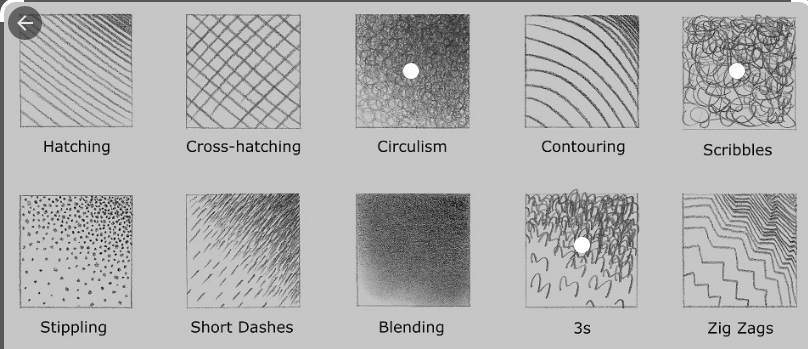
- Give three categories of colours
primary, secondary and tertiary colors. - Draw and label a colour when showing primary and secondary colours
Any drawing showing primary and secondary colours
MUSIC
- Songs sung for the love of your country and its citizens is called.__________Patriotic songs________ (1 mark)
- Name the type of song sung during the following occasion (5 marks)
- School assembly __________Topical songs_________
- Church service _________Religious / sacred songs__________
- National holidays ______Patriotic songs/ national anthem_____________
- Prayer days in school _______Religious / sacred songs____________
- To soothe a child to sleep _______lullaby____________
- The type of song below is ______________Topical song_________________(2 marks)
Corona Ni Atari, wash your hands. Ooh! Wash your hands.
Ooh! Corona Ooh! Corona Stay safe wear mask Ooh! Corona - Name two occasions we perform East African Community Anthem (2 marks)
a) All EAC Summit meetings;
b) All EAC Council meetings;
c) Commemoration of EAC days;
d) When a Head of State addresses EALA;
e) Opening of EALA Sessions
f) Opening of the EACJ Law Year;
g) All regional events such as Conferences, Sports and Cultural Events, Exhibitions.
h) All national occasions in Partner States as each Partner State may determine. - What sol-fa notes do the following signs show (8 marks)
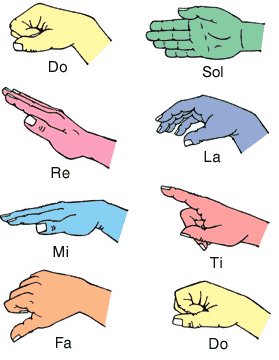
- Name any three voices in a three part song? (3 marks)
LH (Lower Harmony) M (Melody) UH (Upper Harmony) - The participant who leads a song is known as __________________(2 marks)
- A folk song talks about_type of traditional and generally rural music that originally was passed down through families and other small social groups._(2 marks)
Agriculture Questions and Answers - Grade 5 End of Term 1 Exams 2022 SET 1
QUESTIONS
- Grade 5 pupils were investigating on the best soil for modelling. Which answer did they give?
- When making compost manure which activity helps in quick rotting of the compost heap? (Adding ash, Adding kitchen waste, Sprinkling water)
- Which of the animals below can be classified as harmful
- Mongoose
- Dog
- Goat
- The soil which holds very little water is
- Write True or False
Cotton grows very well in loam soil. - Draw a watering can for practicing drip irrigation.
- Which of the following is NOT a use of water in the farm
- Mixing farm chemicals
- Watering animals
- Watering plants
- Explain the use of a scare crow in a farm
- Write 3 materials that can be used to make a scare crow (3mks)
- Write down 2 ways of soil recovery
- ........................... is the carrying away of top fertile soil by water or wind.
- A ................. bed is a small raised area of land prepared to sow seeds.
- Write down two types of waste which should not be put in a waste pit.
- What is the importance of mulching?
- Removing the weak or thin seedlings to allow space for healthy growing seedlings is called (irrigation, transplanting, thinning)
- Draw the tool used by a farmer for transplanting
- What is the colour of unripe tomatoes?.
- Write down two leguminous crops
- Manure adds ................... to the soil.
- Which animal gives us milk and mutton?
ANSWERS
- clay soil
- Adding kitchen waste
- Mongoose
- sandy soil
- True
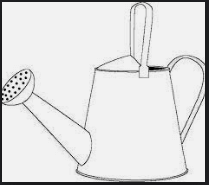
- Mixing farm chemicals
- to deter birds or other animals from eating or otherwise disturbing seeds, shoots, and fruit; its name derives from its use against the crow.
- Grass clippings, hay, wood chips, leaves and rags
- use of green manure (uprooted or sown crop parts incorporated or left on topsoil), cover crops, crop rotation and organic compost.
- soil erosion
- seed
- old batteries, pesticides, paint, and car oil
- Mulches conserve the soil moisture, enhance the nutrients status of soil, control the erosion losses, suppress the weeds in crop plants, and remove the residual effects of pesticides, fertilizers, and heavy metals. Mulches improve the aesthetic value of landscapes and economic value of crops.
- thinning

- green
- beans, soybeans, peas, chickpeas, peanuts, lentils, lupins, mesquite, carob, tamarind, alfalfa, and clover.
- nutrients / organic matter
- sheep
Religious Studies CRE & IRE Questions and Answers - Grade 5 End of Term 1 Exams 2022 SET 1
QUESTIONS
CHRISTIAN RELIGIOUS EDUCATION
- List the responsibilities God has given us over his creation.(1 mk)
- When God created Adam and Eve, He gave man the power to rule over animals. This means that taking care of animals is our ...............(responsibility, talent)(1 mk)
- The sentences below explain what happens to children who experience child labor. Choose an answer from the box below for each sentence.
Body injuries absenteeism tiredness Poor health - Elizabeth misses school at least three times a week....................... (1 mk)
- One of Ezra's eyes is swollen. Some chemicals got into his eye while he was working in the flour factory..............(1 mk)
- Malkia is very thin and weak.............................(1 mk)
- David is always sleepy during lessons.................... (1 mk)
- Rearrange the jumbled letters to get the correct words.
- SAENK (1 mk)
- VEE (1 mk)
- MADA (1 mk)
- DOYSIEB (1 mk)
- How did Adam and eve disobey God? (1 mk)
- Explain the importance of obeying school rules. (1 mk)
- What is family unity? (1 mk)
- Write down the values that promote unity in a family. (3mk)
- What challenges does a family face? (2mk)
- Why is the bible referred to as a guide? (1 mk)
- How does the bible help you relate well with your teachers? (1 mk)
- The word puzzle below has some hidden values that we can acquire through reading the bible. Find the values. (4mk)
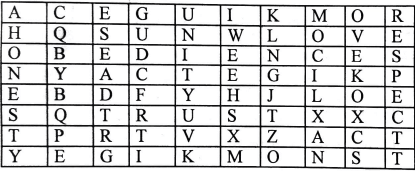
- Who arrested Peter and John? (1 mk)
- Write what you will do to show courage in the following situations:
- Your friend asks you to smoke cigarettes. (1mk)
- Your friend is asking you to watch an ungodly movie. (1mk)
ISLAMIC RELIGIOUS EDUCATION
- Which sura describe the events of the year the elephant.
- "Veryil he who hates you O Mohammad will be cut off from all that is good". Which of the verses below matches this questions.
- Faswal-lilirab-rabika wanbar. '
- In-nal aatwaynakal kaothar'
- Falyaboduu rab-ba haadhalbayi
- In-na shani-aka-huwal abtar.
- The virtues is taught in Suratul Asr.
- The story of the elephant is taught in which Surah?
- Complete the verse from surah Takathur
Nata zur tumol.................... - Worship Allah as if you see him for if you do not see him he sees you. This is a pillar of ......................................
- The best gift to our parents?
- Complete the following hadith
"Paradise is under the feet of our ............................" - When visiting someone's house we should knock .............................. times.
- Write the four sources of fiqh.
- In Islamic sheriah things that annoy others but are not sin are called .....................
- The mother of Nabii Issa was called ...................................
- Blood is an example of .................................. najis
- ................................is the book that was given to prophet Daud.
- ...............................will blow the trumpet on the day of judgement.
MARKING SCHEME
CHRISTIAN RELIGIOUS EDUCATION
- List the responsibilities God has given us over his creation.(1 mk)exercising both dominion and stewardship over the earth
- When God created Adam and Eve, He gave man the power to rule over animals. This means that taking care of animals is our ...............(responsibility, talent)(1 mk)
- The sentences below explain what happens to children who experience child labor. Choose an answer from the box below for each sentence.
Body injuries absenteeism tiredness Poor health - Elizabeth misses school at least three times a week.........absenteeism .............. (1 mk)
- One of Ezra's eyes is swollen. Some chemicals got into his eye while he was working in the flour factory.....Body injuries.........(1 mk)
- Malkia is very thin and weak........Poor health .....................(1 mk)
- David is always sleepy during lessons.........tiredness........... (1 mk)
- Rearrange the jumbled letters to get the correct words.
- SAENK (1 mk) SNAKE
- VEE (1 mk) EVE
- MADA (1 mk) ADAM
- DOYSIEB (1 mk) DISOBEY
- How did Adam and eve disobey God? (1 mk)
THEY ATE THE FORBIDDEN FRUIT - Explain the importance of obeying school rules. (1 mk)
In addition to self-preservation, obedience to school policies and procedures shows that you respect your peers and consider their personal safety to be of the utmost importance. Obedience also demonstrates you believe the education of your peers is vital to their future well-being. - What is family unity? (1 mk)
maintaining the family group without deviation or change. - Write down the values that promote unity in a family. (3mk)
Build a circle of trust.
Find your family purpose. Create a family vision together so that each member becomes an active, willing participant at the outset.
Be your own guru
Check in with everyone.
Rotate leadership.
Share your stories.
Lead with vulnerability.
Communicate, Communicate, Communicate. ...
Establish a family culture. ...
Compassion & Compromise. ...
Consistency is key. ...
Have fun together. - What challenges does a family face? (2mk)
Different personalities clashing and disagreements over ways of doing things.
Jealousy or fighting between brothers and sisters.
Parents arguing.
Divorce or separation.
New step-parents or step-brothers and sisters.
A parent or relative having mental health problems, disabilities or illness. - Why is the bible referred to as a guide? (1 mk)
The Bible is used by Christians to give them guidance about how they can live their their lives in the way God would want them to. - How does the bible help you relate well with your teachers? (1 mk)
By offering guidance - The word puzzle below has some hidden values that we can acquire through reading the bible. Find the values. (4mk)
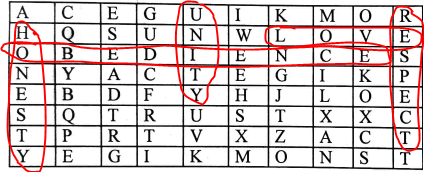
- Who arrested Peter and John? (1 mk)
the temple police - Write what you will do to show courage in the following situations:
- Your friend asks you to smoke cigarettes. (1mk)
say no - Your friend is asking you to watch an ungodly movie. (1mk)
say no and leave
- Your friend asks you to smoke cigarettes. (1mk)
ISLAMIC RELIGIOUS EDUCATION
- Which surah describe the events of the year the elephant.
Surah 105, Al-Fil (Arabic: الـفِـيـل, "The Elephant"), and is discussed in its related tafsir. - "Verily, he that hates thee has indeed been cut off [from all that is good". Which of the verses below matches this questions.
- Faswal-lilirab-rabika wanbar. '
- In-nal aatwaynakal kaothar'
- Falyaboduu rab-ba haadhalbayi
- In-na shani-aka-huwal abtar.
- The virtues is taught in Suratul Asr.
- The story of the elephant is taught in which Surah?
- Complete the verse from surah Takathur
Nata zur tumol.................... - Worship Allah as if you see him for if you do not see him he sees you. This is a pillar of ......................................
- The best gift to our parents?
- Complete the following hadith
"Paradise is under the feet of our ............................" - When visiting someone's house we should knock .............................. times.
- Write the four sources of fiqh.
- In Islamic sheriah things that annoy others but are not sin are called .....................
- The mother of Nabii Issa was called ...................................
- Blood is an example of .................................. najis
- ................................is the book that was given to prophet Daud.
- ...............................will blow the trumpet on the day of judgement.
Environment & Religious Activities Questions and Answers - Grade 5 End of Term 1 Exams 2022 SET 1
QUESTIONS
Social Studies
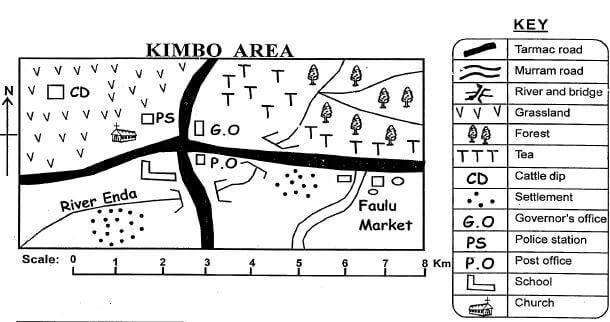
Use the map of Kimbo Area to answer questions 1 - 4.
- What is the climate of the North Eastern region of Kimbo Area? (1 mark)
- Who is the head of Kimbo Area? (1 mark)
- What is the religion of the people in Kimbo Area? (1 mark)
- River Enda flows towards which direction? (1 mark)
- List any 2 elements for a map. (2 marks)
- A compass has how many cardinal points? (1 mark)
Use the map of Kenya below to answer questions 7 - 10:
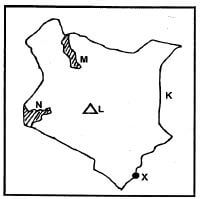
- The country that boarders Kenya marked K is (1 mark)
- The lake marked M is called (1 mark)
- The mountain marked L is known as (1 mark)
- The lake marked N is known as (1 mark)
- What is weather? (1 mark)
- What is climate? (1 mark)
- List any 4 historic built environments in Kenya. (4 marks)
- List any 3 methods of instruction used in traditional education in promoting values. (3 marks)
- List any 2 administrative leaders in a school.(2 marks)
- Outline any 4 duties of administrative leaders in school. (4 marks)
- List 4 language groups in Kenya. (4 marks)
Assessment Rubrics - Social Studies
| Level | 4 | 3 | 2 | 1 |
| Score | 28-30 | 19-27 | 10-18 | 0-9 |
C.R.E
- Outline 3 lessons that we can learn from the parable of the talents. (3 marks)
- Identify any 3 responsibilities given to human beings by God. (3 marks)
- Give 4 causes of child labour. (4 marks)
- Give 4 lessons learnt from the fall of human beings in the garden of Eden. (4 marks)
- List the 3 members of a nuclear family. (3 marks)
- State 2 uses of the Bible. (2 marks)
- List down the first 5 books of the New Testament of the Bible. (5 marks)
- Give two good qualities learnt from the story of Peter and John at the temple. (2 marks)
- Name the three sons of Noah. (3 marks)
- Prophet Elijah held a contest with the false prophets of Baal at Mount (1 mark)
Assessment Rubrics - CRE
| Level | 4 | 3 | 2 | 1 |
| Score | 28-30 | 19-27 | 10-18 | 0-9 |
MARKING SCHEME
SOCIAL STUDIES
- Cool and wet
- Governor
- Christianity
- South West
- Frame, title, key, compass
- 4
- Somalia
- Turkana
- Kenya
- Victoria
- Daily changes in the atmosphere
- Average changes in the atmosphere over a long period of time
- Museum, monuments
- Proverbs, stories, riddles
- Headteacher, prefect, deputy headteacher
- -Ensuring the school is clean
-Ensuring the school is safe
-Ensuring learners are following set rules
-Punishing learners who break laws - Nilotes, Cushites, Bantus, Semites
C.R.E
- -We should use our abilities well
-We should be honest
-We should be hardworking - -Taking care of God's creation
-Giving birth
-oberying God's commandments - -Poverty
-Lack of parental care
- Death of parents
- Peer influence - -We should be obedient
- We should follow God's commands
- We should tell the truth always
-Sin separates us from God - Mother, father, children
- -Reading to learn God's word
- Reading in school when learning C.R.E - Matthew, Mark, Luke, John, Acts
- Faith, courage
- Shem, Ham, Japheth
- Carmel
Monitoring Learners' Progress - Grade 5 Competence Based Assessment Term 1 2022 Social Studies Activities
QUESTIONS
- Draw and Name four cardinal points of a compass (4marks)
- Name five main elements of a map (5 marks)
- Name two example of a museum in Kenya ( 2marks)
- Why is a museum important to people (1 marks)
- Give 3 examples of Proverbs from your community (3 marks)
- Give two examples of Riddles from your community (2 marks)
- Who are the three leaders in a school administration (3 marks)
- 2 Examples of skills that were put on the African way of education (2 marks)
- What are the two duties of a deputy head teacher in a school (2marks)
- Give five examples of relief features (5 marks)
- Draw and design a method of instruction used in African traditional education (4 marks)
- What are the two things you should do to support leaders in your school (2marks)
- What are the three importance of prefects in a school (3marks)
- Give three examples of Valleys in Kenya (3 marks)
- What is a monument (2marks)
- What are the 5 examples of language groups in Kenya (5 marks)
- Name two mountains found in Kenya (2marks)
- Name two plains found in Kenya (2marks)
- What is weather ___________________________________________(2marks)
- Answer the following questions according to the instructions given (3marks)
- What is the size of Kenya in square kilometers ________________________
- How many countries share a border with Kenya __________________
- What is the name of your county_______________________________________
- Give three examples of the neighbors of your County (3marks)
| Exceeding Expectation | Meeting Expectation | Approaching Expectation | Below Expectation |
| 50 - 60 | 40 - 49 | 20 - 39 | 0 - 19 |
Kiswahili Questions and Answers - Grade 5 End of Term 1 Exams 2022 SET 1
MASWALI
SEHEMU 1: KUSIKILIZA NA KUZUNGUMZA
Mwalimu amsomee mwanafunzi kifungu hiki kisha amwulize maswali yafuatayo.
Paka yuko jikoni. Amebeba panya mdomoni. Panya huyo ni mweusi. Paka anajificha mvunguni mwa meza. Mama anamwona paka.
- Paka yuko wapi?
(Mwanafunzi ajibu) - Paka amebeba nini mdomoni?
(Mwanafunzi ajibu) - Panya huyo ni wa rangi gani?
(Mwanafunzi ajibu) - Paka anajificha wapi?
(Mwanafunzi ajibu) - Nani anamwona paka?
(Mwanafunzi ajibu)
Vigezo vya Kutathminia Kusikiliza na kuzungumza
| Kiwango cha utendaji | 4 | 3 | 2 | 1 |
| Upeo/Alama | 5 | 4 | 3 | 0 - 2 |
SEHEMU 2: KUSOMA KWA SAUTI (Alama 5)
Mwanafunzi asome kifungu hiki kwa sauti.
Ilikuwa siku ya Ijumaa tulipokuwa sebuleni tukitazama runinga. Sabu alianza kutusimulia jinsi ambavyo mwalimu wao alikuwa akiwaeleza kuhusu umuhimu wa miti. Hata ingawa alikuwa shuleni miaka sitini iliyopita, alikuwa akiyakumbuka vizuri.
Alianza kwa kusema kuwa mwalimu wao alisema kuwa miti huwa ni maskani ya wanyama mbalimbali sanasana nyuni ambao hutengeneza viota vyao na kutagia mayai humo. Aliendelea kutuambia kuwa wanyama wengine wanaotegemea miti kama makazi ni wanyamapori kama vile simba, chui, pundamilia na wengine.
Vigezo vya Kuathminia - Kusoma
| Kiwango cha utendaji | 4 | 3 | 2 | 1 |
| Maneno yaliyosomwa katika dakika moja | 60 na zaidi | 41 - 60 | 21 - 40 | 0-20 |
SEHEMU 3: UFAHAMU (Alama 5).
Mwanafunzi asome kifungu hiki na kujibu maswali.
- NDOTO YA AMINA
Babu alimnunulia Amina godoro na foronya. Usiku alipolala aliota ndoto. Aliota kuwa alikuwa msichana mkubwa. Alikuwa akifanya kazi ya ualimu. Baada ya miaka miwili aliacha ualimu akawa mkulima. Aliuza mazao akapata shilingi laki tatu. Alipokuwa akipeleka pesa zake benkini, aliamka kutoka usingizini.- Nani alimnunulia Amina godoro?
- Aliota ndoto wakati gani?
- Mara ya kwanza alikuwa akifanya kazi gani?
- Baada ya miaka miwili alianza kufanya kazi gani?
- Alikuwa akipeleka pesa zake wapi?
- MWALIMU BIDII
Mwalimu Bidii ni mwalimu wa Kiswahili. Anafundisha katika shule ya msingi ya Hekima. Kila siku yeye hutukumbusha kuwa tuwe watoto safi. Kuna siku alituletea ndizi. Tulifurahia mno. Alituahidi kuwa atatupeleka jijini Mombasa.- Mwalimu Bidii hufundisha somo gani?
- Mwalimu Bidii hufundisha katika shule gani?
- Mwalimu Bilii huwahimiza wanafunzi kuwa watoto
- Mwalimu aliwaletea nini?
- Mwalimu aliwaahidi kuwa atawapeleka wapi?
Vigezo vya Kutathminia - Ufahamu
| Kiwango cha utendaji | 4 | 3 | 2 | 1 |
| Upeo/Alama | 5 | 4 | 3 | 0 - 2 |
SEHEMU 4: SARUFI
Tunga sentensi ukitumia maneno haya.
- jiwe
- embe
- mwiko
- soko
- fimbo
Andika sentensi kwa wingi.
- Kiatu chake kimeraruka.
- Mtoto yule anakula tunda.
- Goti lake limeumia.
- Kioo hiki kilivunjika jana.
- Meza hii ni ya mwanafunzi.
Andika akisami kwa maneno.
- 1/6 -
- 1/4 -
- 1/2 -
- 1/3 -
- 1/5 -
Geuza maneno yafuatayo katika hali ya ukubwa.
- Mto -
- Mtu -
- Mke -
- Mti -
- Mji -
Vigezo vya kutathminia - Sarufi
| Kiwango cha utendaji | 4 | 3 | 2 | 1 |
| Upeo/Alama | 19-20 | 13-18 | 7-12 | 0 - 6 |
SEHEMU 4: KUANDIKA
INSHA Andika insha juu ya:
NYUMBANI KWETU
Vigezo vya kutathminia - Kuandika
| Kiwango cha utendaji | 4 | 3 | 2 | 1 |
| Upeo/Alama | 19-20 | 13-18 | 7-12 | 0 - 6 |
MAJIBU
SEHEMU 1: KUSIKILIZA NA KUZUNGUMZA
Mwalimu amsomee mwanafunzi kifungu hiki kisha amwulize maswali yafuatayo.
Paka yuko jikoni. Amebeba panya mdomoni. Panya huyo ni mweusi. Paka anajificha mvunguni mwa meza. Mama anamwona paka.
- Paka yuko wapi?
Jikoni - Paka amebeba nini mdomoni?
Panya - Panya huyo ni wa rangi gani?
Mweusi - Paka anajificha wapi?
mvunguni mwa meza - Nani anamwona paka?
Mama
Vigezo vya Kutathminia Kusikiliza na kuzungumza
| Kiwango cha utendaji | 4 | 3 | 2 | 1 |
| Upeo/Alama | 5 | 4 | 3 | 0 - 2 |
SEHEMU 2: KUSOMA KWA SAUTI (Alama 5)
Mwanafunzi asome kifungu hiki kwa sauti.
Ilikuwa siku ya Ijumaa tulipokuwa sebuleni tukitazama runinga. Sabu alianza kutusimulia jinsi ambavyo mwalimu wao alikuwa akiwaeleza kuhusu umuhimu wa miti. Hata ingawa alikuwa shuleni miaka sitini iliyopita, alikuwa akiyakumbuka vizuri.
Alianza kwa kusema kuwa mwalimu wao alisema kuwa miti huwa ni maskani ya wanyama mbalimbali sanasana nyuni ambao hutengeneza viota vyao na kutagia mayai humo. Aliendelea kutuambia kuwa wanyama wengine wanaotegemea miti kama makazi ni wanyamapori kama vile simba, chui, pundamilia na wengine.
Vigezo vya Kuathminia - Kusoma
| Kiwango cha utendaji | 4 | 3 | 2 | 1 |
| Maneno yaliyosomwa katika dakika moja | 60 na zaidi | 41 - 60 | 21 - 40 | 0-20 |
SEHEMU 3: UFAHAMU (Alama 5).
Mwanafunzi asome kifungu hiki na kujibu maswali.
- NDOTO YA AMINA
Babu alimnunulia Amina godoro na foronya. Usiku alipolala aliota ndoto. Aliota kuwa alikuwa msichana mkubwa. Alikuwa akifanya kazi ya ualimu. Baada ya miaka miwili aliacha ualimu akawa mkulima. Aliuza mazao akapata shilingi laki tatu. Alipokuwa akipeleka pesa zake benkini, aliamka kutoka usingizini.- Nani alimnunulia Amina godoro?Babu
- Aliota ndoto wakati gani? Usiku
- Mara ya kwanza alikuwa akifanya kazi gani? Ualimu
- Baada ya miaka miwili alianza kufanya kazi gani? Mkulima
- Alikuwa akipeleka pesa zake wapi? benkini
- MWALIMU BIDII
Mwalimu Bidii ni mwalimu wa Kiswahili. Anafundisha katika shule ya msingi ya Hekima. Kila siku yeye hutukumbusha kuwa tuwe watoto safi. Kuna siku alituletea ndizi. Tulifurahia mno. Alituahidi kuwa atatupeleka jijini Mombasa.- Mwalimu Bidii hufundisha somo gani? Kiswahili
- Mwalimu Bidii hufundisha katika shule gani? shule ya msingi ya Hekima
- Mwalimu Bilii huwahimiza wanafunzi kuwa watoto safi
- Mwalimu aliwaletea nini? Ndizi
- Mwalimu aliwaahidi kuwa atawapeleka wapi? Mombasa
SEHEMU 4: SARUFI
Tunga sentensi ukitumia maneno haya.
( Mwanafunzi awe amejibu maswali yakiwa yamejibiwa yapasavyo apewe alama)
- embe - Embe ni tunda tamu na lenye vitamini nyingi
- mwiko - Mama aliutumia mwiko kupika ugali.
- soko - Tulienda soko na baba tukanunua maembe.
- fimbo - Mkulima alitumia fimbo kufukuza mbwa alikua akitaka kula kuku.
Andika sentensi kwa wingi.
- Kiatu chake kimeraruka.
Viatu vyao vimeraruka. - Mtoto yule anakula tunda.
Watoto wale wanakula matunda. - Goti lake limeumia.
Magoti yao yameumia. - Kioo hiki kilivunjika jana.
Vioo hivi vilivunjika jana. - Meza hii ni ya mwanafunzi.a sixth1/6
Meza hizi ni za wanafunzi.
Andika akisami kwa maneno.
- 1/6 - sudusi / moja ya sita
- 1/4 - robo / moja ya nne
- 1/2 - nusu
- 1/3 - thuluthi
- 1/5 - hamusi / moja ya tano
Geuza maneno yafuatayo katika hali ya ukubwa.
- Mto - jito
- Mtu - jitu
- Mke - janajike
- Mti - jiti
- Mji - Jiji





